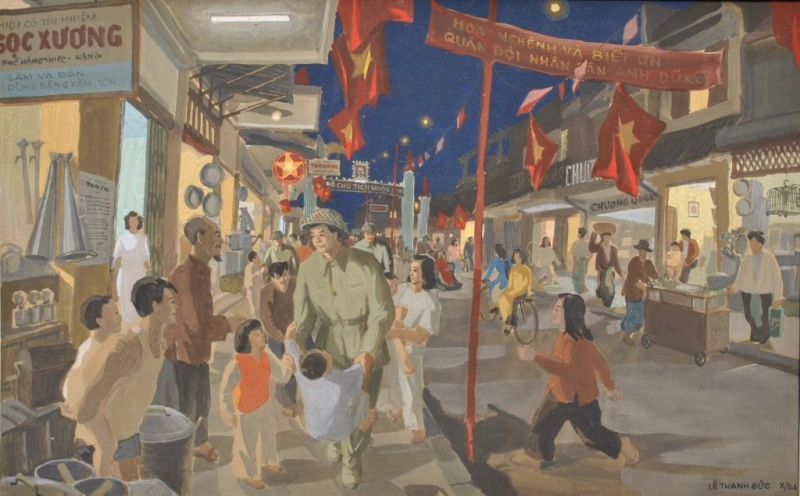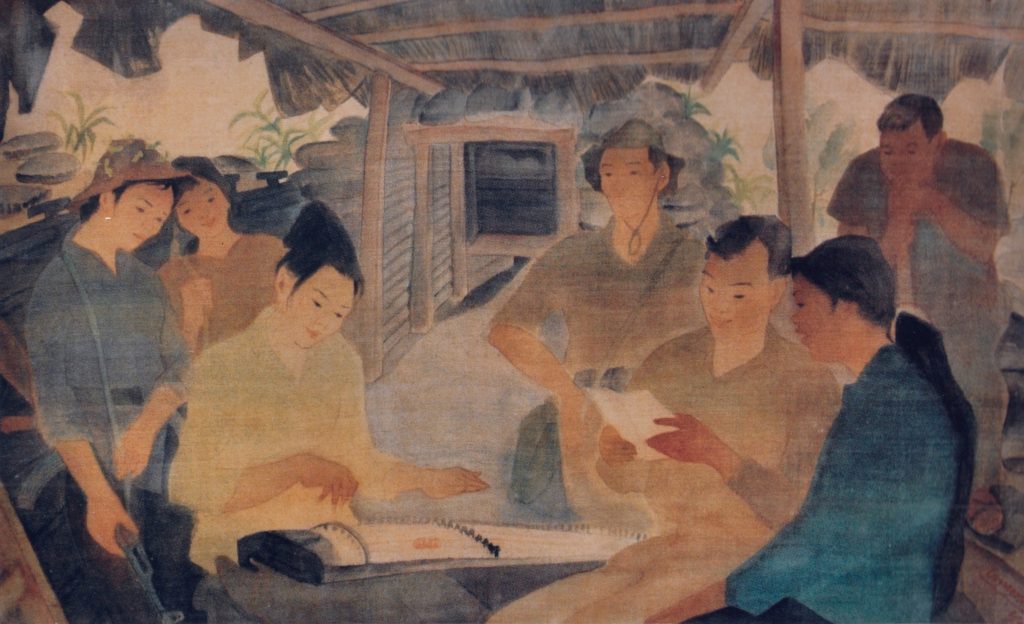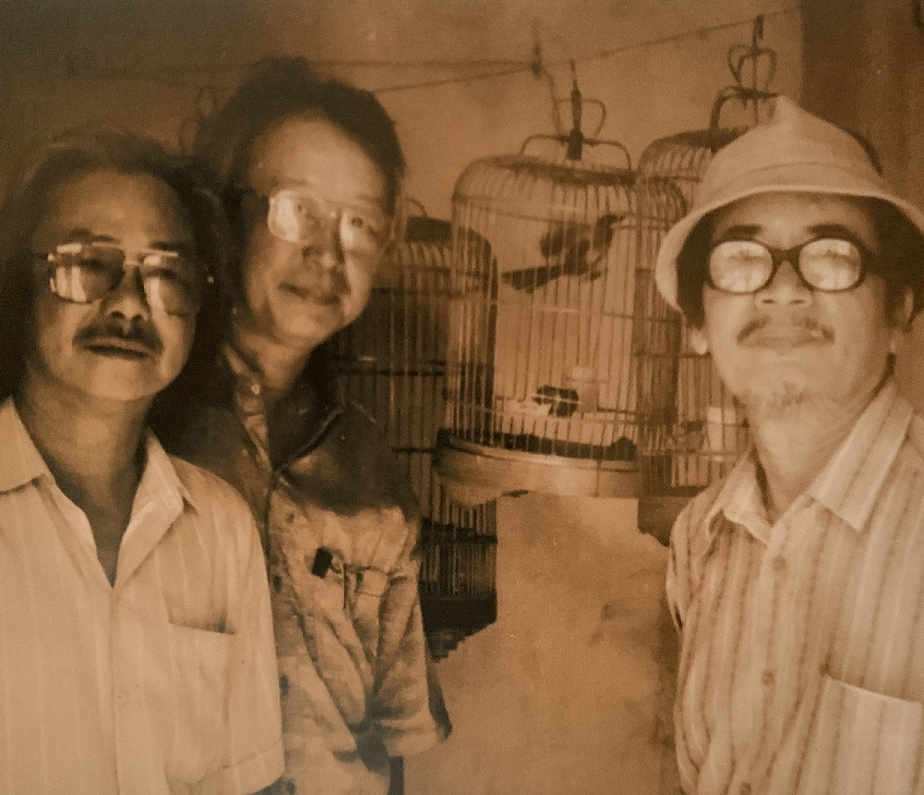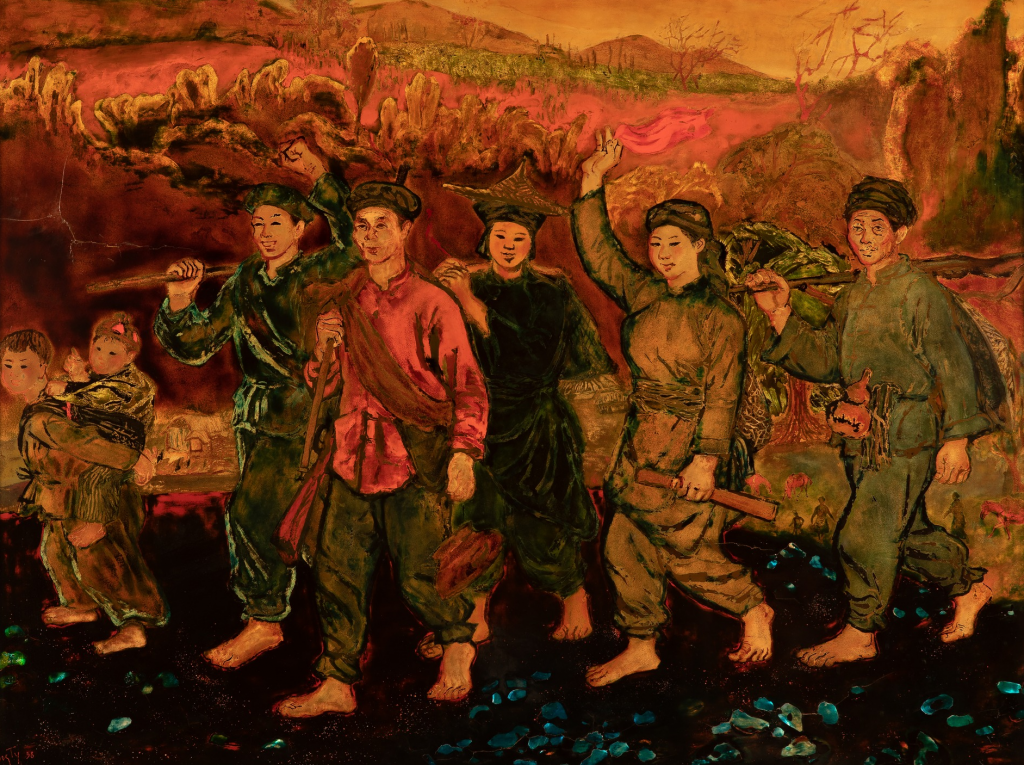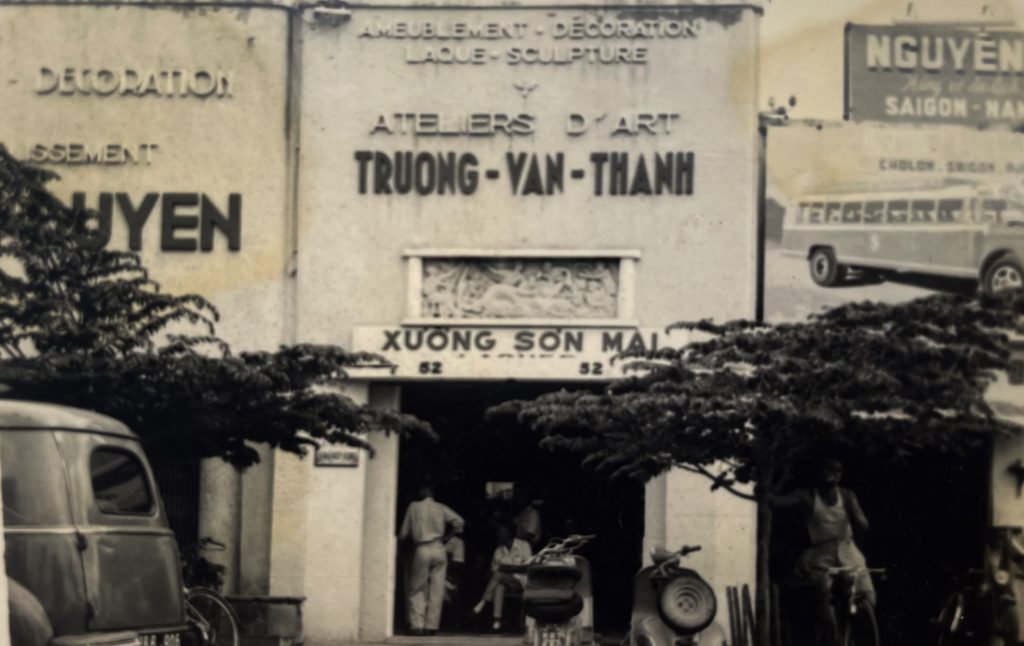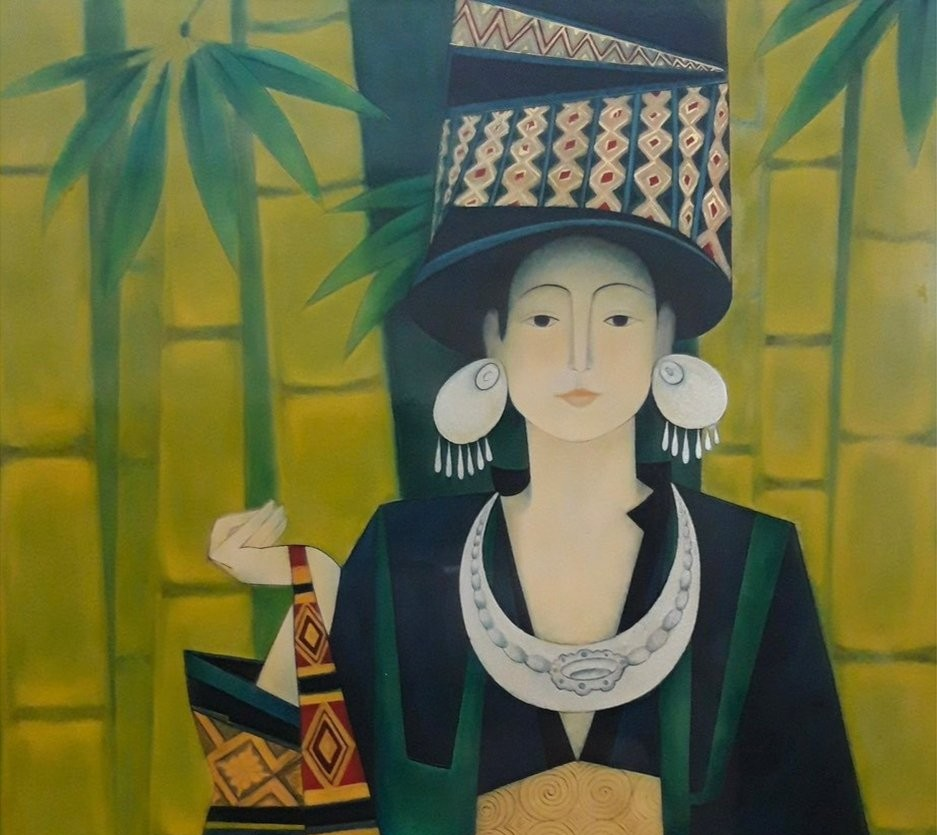To continue the column ‘GREAT BOOKS—SHARING WITH ART LOVERS’, Viet Art View would like to share with you the fourth story from the book ‘Painter Nguyễn Phan Chánh’ by Nguyệt Tú and Nguyễn Phan Cảnh, Culture Publishing House, 1979, a collection of articles related to the life and career of painter Nguyễn Phan Chánh.
Fourth story:
THE BASKET OF NEW YEAR PAINTING
The provincial market on 26 tháng chạp [the 12th month in lunar calendar] was crowded with people shopping for New Year. The market stalls were packed with their goods. Sellers had to display their goods on both sidewalks and on both sides of the street in front of the market.
Chánh and a neighbor friend rented a seat in the small grocery communal house to sell New Year paintings. His friend spent money to buy pink paper, purple paper and to rent the seat at the market. Painting sold, money divided.
Three days before the crowded market for the New Year, Chánh and his mother were busy preparing two big baskets full of paintings. Every time a new year came, the baskets had new items.
From 11 month and 12 month, Chánh had paid attention to buy black ink and colours. Taking the boat along to Vinh, he had bought good colours, then seeing the scenery of Quyết mountain, Bến Thủy river, far and near, hidden then appeared beautifully like in a painting, he was very happy.
Once Chánh got colours and paper, he was busy painting all day. The whole family was happy that this new year, if they could sell a lot of paintings, they would buy many things to celebrate. In addition to firecrackers and incense, there could also be pork.
Chánh glued white paper together, made it long and wide. Every three sheets of student paper made into a painting. Pencil sketch first, then ink, then color. Four paintings made a set, depicting the plays of Mã Long, Mã Phụng, Sơn Hậu, Tam Quốc, Hồng Môn, hội ẩm. On the worshiping painting, there were Thần Trà, Uất Lũy, Tiến Tài, Tiến Lộc.
Chánh used paper to make lotus, flowers and buds, with stems plugged into ornamental pots. He also collected dried branches to make apricot and peach.
Standing next to the two painting baskets, the boys going to New Year market were delighted to choose some animals painted with lime and vermilion, they held whistles in their mouths. Those animals, at first Chánh only made for his baby siblings to play, after the children in the neighborhood asked to buy them, Chánh made more, sold them with New Year paintings.

Maiden with goldfish. 1939. Silk. 40×60 cm. The book ‘Nguyễn Phan Chánh silk painting’, of Vietnam Fine Arts Museum, published in 1992.
The elders liked to buy Tùng- Cúc- Trúc- Mai paintings, Cranes standing on turtle’s back or Sơn Hậu paintings. The paintings of Tiến Tài, Tiến Lộc… were chosen by many people. Chánh and his mother opened up two baskets, display paintings for people to choose freely.
– I take two of Mã Long, Mã Phụng.
A woman with a basket full of oranges and firecrackers, holding two paintings in her hand. The paintings were as long as a couplets. A father and son from the countryside with brown pants, short shirt, pointing at the small paintings:
– Please roll these two Tiến Tài, Tiến Lộc for us.
Along with New Year paintings, Chánh also made paintings of mountain and river, castles, bushes near and far, water, boats, fishers, buffalo boy, woodcutter, and people plowing. A beautiful painting on the wall or a flower branch made of paper for the ancestral altar, everyone tried to have it on three days of New Year.
Near the end of the market, an old man with gray hair but still agile came to the front of the painting stall.
– Sir, would you like this painting?
Chánh introduced to the old man a landscape painting. After an old painting, Chánh drew an old man leaning on a stick, holding a wine gourd in his hand, asking a buffalo boy for directions, the boy was crossing a bridge in the village. In the distance loomed village bamboo and undulating roofs. On a bamboo tree there was a nêu pole with a small flag…
The old man looked at the two paintings for a long time, then smiled widely:
– I want to buy both.
The paintings had already been wrapped and given to the customer, but Chánh was still looking at it, feeling as if he had lost a precious object. Chánh’s mother consoled:
– You can make another one, dear.
But Chánh knew that he wouldn’t be able to paint another painting exactly like that again. That gentle brown painting was an unforgettable memory of the meeting during Nam Hà village festival last spring, a spring with many sweet olives flowers.
Sweet olives were white, fragrant. The fragrance in front of the temple gate of Nam Hà village that year seemed to had attracted many young men and women from neighboring villages to attend the festival.
Youth was full of surprises. Chánh was dragged by friends to see the festival, hurriedly borrowed a knee-length dark shirt and a pair of white pants with pleats, a scarf on his head, and an umbrella in his hand. Needed a pair of shoes but couldn’t find any, Chánh had to wear new wooden clogs. The high heels made Chánh a little taller.
Crossing the bamboo bridge across the Tân Giang River, Chánh and his friends aged sixteen and seventeen invited each other to the festival. From afar, the sound of drums was heard. In order to reach the crowded place on the high dunes, they still had to cross a wide field. The storks were snooping in the water fields, hearing the sound of people, flapping their wings and soaring high, creating dots in the clear blue sky.
Teaching in Đồng Môn village last year, in a family with three students, Chánh had the looks of a teacher. While friends rushed into pubs and bars to flirt and joke with flashy salesgirls from the province, Chánh wandered around to admire the scenery of the temple. Under the shadow of the big Chinese banyan tree, luxuriant branches and leaves, the ancient temple was as beautiful as in a painting. Chánh walked alone beside the groves of sweet olives.
– Mr. Teacher! Give Mrs. Teacher a piece of betel and areca…
The sound of someone behind Chánh startled him and he turned around. Black eyes, gentle smile of a girl about fourteen or fifteen made Chánh feel fluttering in his heart. The slanted hat covered her rosy cheeks.
– She said something strange.
The girl with black eyes nestled on the shoulder of her friend who was asking for betel and areca for her and meant to blame the friend.
The friend pushed the girl in front of the person she called Mr. Teacher. Chánh was both touched and embarrassed, hurriedly ran to the side of an old woman’s stall, asked for a piece of betel and areca with phoenix wings, and gave it into his new friend’s hand. She was shy, but the piece of betel and areca was still received. Betel and areca made the date. With hand giving the piece, Chánh’s eyes glanced at the girl with rosy cheeks who was still shyly hiding behind the friend.
“We met for what”…
The two girls left, but Chánh was still standing alone.
On the way back home, in the afternoon of that festival, hearing the sound of the wind blowing, Chánh felt his heart was empty. Across the wide field, the wind blew stronger. A woman carrying groceries came home late from the market, saw the boy wandering on the edge of a field, let out a song. Chánh felt even more sad. The poor student looked at the village scene at that time, how boring it was.
Friends invited Chánh to Đồng Môn weaving village to sing. As soon as they reached the beginning of the village, they heard the rattle of the joyful cheers, the singing of the girls was bold and earnest:
“Advice you to read books and recite poems
I will take care of the oil and the lights”
Under the lights, the girls sat by the loom and sang with the teachers from the province. Chánh caught a glimpse of a girl looking at him and said to her friend:
– Did he come to see us?
Young Chánh knew that the girls paid attention to him, not like someone whose mother had a tiled house, just because of his name as a gentle and hardworking teacher, loved by his students. Chánh sang with his friends, but still felt that his heart was not in the song.
At the end of that year, when Chánh painted, he was busy making after an old painting that he liked very much. That was the painting that the old man bought in the New Year market on the 26th day. The painting depicted a village girl wearing a scarf, a brown áo dài, black silk pants, sitting under a tree by the roadside. Oval face, gentle. The hat next to her. In the distance, the sun was about to set behind the top of the mountain. In the middle of the sky, a flock of birds was flying back to their home. Below the painting, there were some words:
“The bird flies to the mountain, it’s dark,
You don’t worry, why sit here?”
Chánh had given all his soul to illustrate the old painting of the elders and imagined the girl in the painting… Not a stranger. It was the girl he met in that spring Nam Hà festival.
(Excerpt from the book ‘Painter Nguyễn Phan Chánh’ by Nguyệt Tú – Nguyễn Phan Cảnh, Culture Publishing House, published in 1979)


